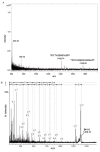The nucleotide sequence and genome organization of Plasmopara halstedii virus
- PMID: 21410989
- PMCID: PMC3069955
- DOI: 10.1186/1743-422X-8-123
The nucleotide sequence and genome organization of Plasmopara halstedii virus
Abstract
Background: Only very few viruses of Oomycetes have been studied in detail. Isometric virions were found in different isolates of the oomycete Plasmopara halstedii, the downy mildew pathogen of sunflower. However, complete nucleotide sequences and data on the genome organization were lacking.
Methods: Viral RNA of different P. halstedii isolates was subjected to nucleotide sequencing and analysis of the viral genome. The N-terminal sequence of the viral coat protein was determined using Top-Down MALDI-TOF analysis.
Results: The complete nucleotide sequences of both single-stranded RNA segments (RNA1 and RNA2) were established. RNA1 consisted of 2793 nucleotides (nt) exclusive its 3' poly(A) tract and a single open-reading frame (ORF1) of 2745 nt. ORF1 was framed by a 5' untranslated region (5' UTR) of 18 nt and a 3' untranslated region (3' UTR) of 30 nt. ORF1 contained motifs of RNA-dependent RNA polymerases (RdRp) and showed similarities to RdRp of Scleropthora macrospora virus A (SmV A) and viruses within the Nodaviridae family. RNA2 consisted of 1526 nt exclusive its 3' poly(A) tract and a second ORF (ORF2) of 1128 nt. ORF2 coded for the single viral coat protein (CP) and was framed by a 5' UTR of 164 nt and a 3' UTR of 234 nt. The deduced amino acid sequence of ORF2 was verified by nano-LC-ESI-MS/MS experiments. Top-Down MALDI-TOF analysis revealed the N-terminal sequence of the CP. The N-terminal sequence represented a region within ORF2 suggesting a proteolytic processing of the CP in vivo. The CP showed similarities to CP of SmV A and viruses within the Tombusviridae family. Fragments of RNA1 (ca. 1.9 kb) and RNA2 (ca. 1.4 kb) were used to analyze the nucleotide sequence variation of virions in different P. halstedii isolates. Viral sequence variation was 0.3% or less regardless of their host's pathotypes, the geographical origin and the sensitivity towards the fungicide metalaxyl.
Conclusions: The results showed the presence of a single and new virus type in different P. halstedii isolates. Insignificant viral sequence variation indicated that the virus did not account for differences in pathogenicity of the oomycete P. halstedii.
Figures

References
-
- Honkura R, Shirako Y, Ehara Y, Yamanaka S. Two types of virus-like particles isolated from downy mildew diseased rice plants. Ann Phytopath Soc Japan. 1983;49:653–658.
-
- Shirako Y, Ehara Y. Composition of viruses isolated from Sclerophthora macrospora-infected rice plants. Ann Phytopath Soc Japan. 1985;51:459–464.
Publication types
MeSH terms
Substances
LinkOut - more resources
Full Text Sources
Research Materials
Miscellaneous

